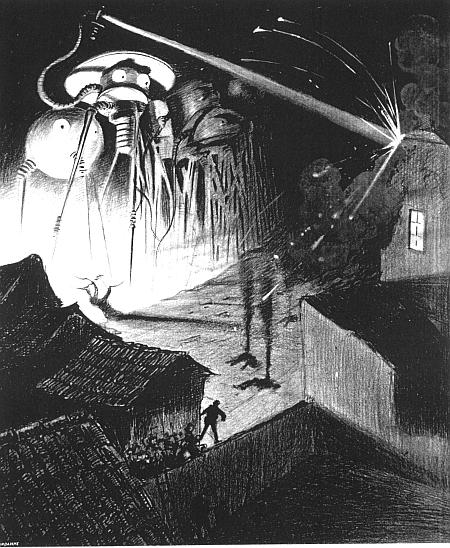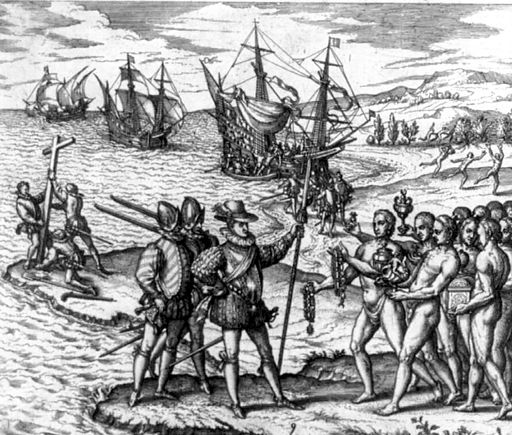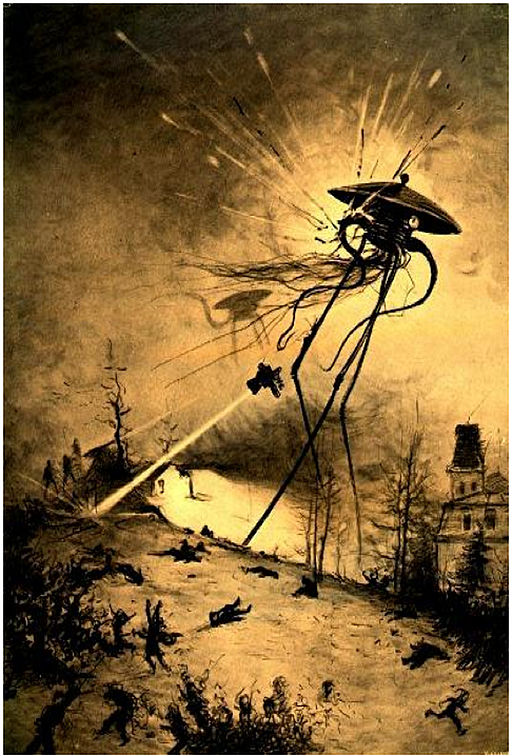Spoilers for The War of the Worlds
H.G. Wells’s The War of the Worlds was a sensation when it was written in 1897. As much as anyone knew it might as well have been realistic. Us young folk forget how little anyone knew about Mars. Its ending was especially realistic. But only sort of.
 Pew pew! We have technology exactly as advanced as you can imagine!
Pew pew! We have technology exactly as advanced as you can imagine!
The story is of a Martian invasion that comes about suddenly and violently. The Martians land and their ships start incinerating onlookers. They travel in giant walking machines and nothing can stop them. These parts were depicted faithfully in the 2005 film starring Tom Cruise.
The ending is fatalistic. The humans never find a way to defeat the Martians. A plague kills them first. In the film, Morgan Freeman’s narration explains that man earned his right to Earth through the millenia he’d spent learning to live with germs or fighting them or… well, it doesn’t really matter what romantic spin you put on it. It’s bull-hockey.
 Look at that pale guy. Let's challenge him to a sneezing contest.
Look at that pale guy. Let's challenge him to a sneezing contest.
It’s not based on poor reasoning. History offers us an example, though it was the invaders who wrote that history. Jared Diamond’s Guns, Germs, and Steel describes how the European invaders in the New World brought germs with them. They were germs that they cultivated, accidentally, through millenia of living close together and living close to live stock.
The natives of the New World didn’t have much live stock and they were more spread out than the Europeans. So instead of occasionally dying out in vast waves of disease, they enjoyed a relative quarantine from each other. The worst diseases would wipe out local groups and have nowhere else to go. Except syphilis. Syphilis will always be with you. I think Jesus said that.
But the other side of the coin was that the European survivors emerged stronger and the diseases got a chance to live alongside them. So when the Europeans showed up in the New World, they brought their favorite diseases with them. Diseases well-honed to kill slowly so their hosts could travel around and they could cover the country.
Now imagine it the other way around. Several peoples of the New World were approaching the level of technology necessary to sail across the Atlantic. Imagine they had sailed to Spain and tried to invade it, as the Martians flew to Earth in H.G. Wells’s book.
The New World invaders would have run into exactly the same problem. They would have succumbed to the diseases of the Europeans.
H.G. Wells was surely aware of this or of other historical examples. Unfortunately he got it wrong.
The people of the New World were wiped out by the plagues of the invaders for one key reason. They were humans.
 All the dangerous germs are on the outside of this creature.
All the dangerous germs are on the outside of this creature.
Human diseases affect humans. And unless Martians are humans, they do not affect Martians. You do not share your cold with your dog. And your dog will not give you distemper. Only a few nasty diseases jump between humans and the animals they spend time with. And each of those germ species needed time to evolve that ability.
Real Martians, with a different evolutionary descent than humans, would shrug off human germs as if they were water. Assuming they aren’t the kind of Martians that melt in water.
Maybe I’m being obnoxious. H.G. Wells had something to say, and it’d probably do me well to read his book again and listen this time. I can look past this weakness. I just wanted to remind folks of how germs really work. In this respect Jean-Paul Sartre was right. Hell is other people.
H.G. Wells was a genius, but the facts ruin of The War of the Worlds at the last second. https://t.co/DJ2uRYxuQF
— Dan Kuck-Alvarez (@dankuck) December 20, 2016

 ,
, 